All Glories to Parama Karuna Sri Sri Nitai-Gaurachandra
A Venezuelan Paradise
Caracas, Venezuela. November 2004
|
It was early morning when we began the journey to the new land for the future temple in Venezuela. Antarjami Prabhu had planned this trip so that we could leave Caracas after mangal arati, and return in time for the evening arati. As we began to drive farther away from the noisy city of Caracas the landscape began to transform. Instead of huge buildings and houses there were small villages, and the houses were made of mud and palm. Instead of tall filthy grey buildings and polluted trees, there were exotic fruit trees and lavish vegetation on both sides of the road. The sky looked cleaner, and the air more pure. Parrots flew in the sky to some quiet forest where they could chirp and chatter on a tree branch. Krsna Bandhu Prabhu turned the steering wheel here and there to avoid the swerving trucks. Swerving cars snaked up and down the hills. We stopped at an agricultural store along the way to look for the needed outfits to cultivate honey for the temple. We met a nice couple who showed us the different kinds of protective gear and masks. The lady asked my mom about her sari, and learned a little something about the Hare Krsna Temple. They mentioned how they would like to go. We left about ten minutes later and continued driving on the dirt roads. Antarjami Prabhu kept looking over from the front seat to make sure we were doing all right. I looked out the window as we approached the road to the land. |
|
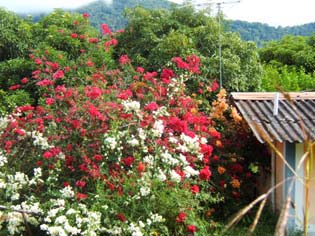
Along the driveway there were typical Venezuelan houses with colored walls decorated with different kinds of flowers, and with hammocks outside. |
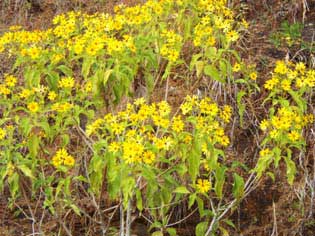
As we made our way to the neighborhood gate, yellow flowers radiated their vibrant yellow as we zoomed by on the bumpy mud clay road. |
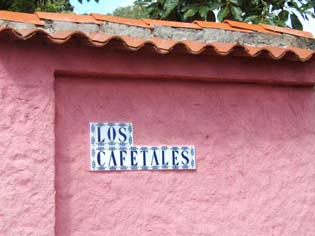
Approaching the entrance to the private driveway, I wondered why it was named "Los Cafetales." |
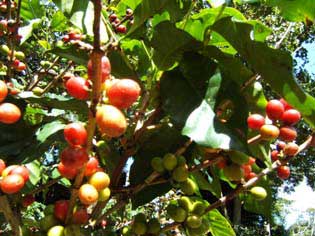
A while back this land used to grow many coffee plants, which have by now been chopped down. 'Cafe' means coffee in Spanish, so 'Los Cafetales' means 'The Coffees.' We stopped the white jeep so I could get a close up of the remaining coffee plants. |

The devotees were very happy to show us the new paradise, and opened the gate with much fervor. I felt anxious to see this land and imagined the plans for the future. Up the road ahead, I could see the sun shining and the hibiscus trees blooming with flowers. |
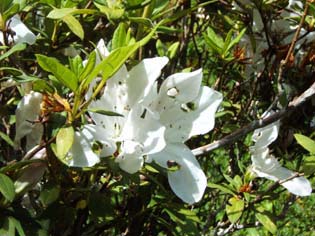
This is a white hibiscus flower. Srila Govinda Maharaj mentioned at Purujit Prabhu's house that we are able to offer these to the deities, as long as they are not red. When red, these are used for offering to Lord Shiva and Mother Durga. |
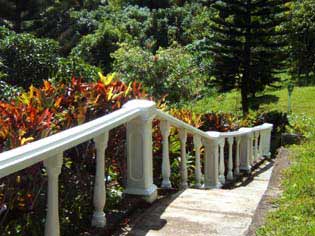
A black and brown dog greeted us as we parked the car. As I stepped out of the car I made my way up the stairway. The sun made the scent of the flowers stronger and accentuated the many different colors of green. I followed the stairway leading to the houses, stopping to look around me at every step. Pausing to look at the distant mountains, a butterfly fluttered near my face and landed on a mango tree. |
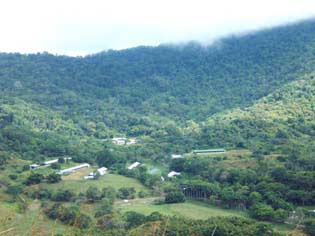
The distant mountains and the small villages waiting to be introduced to Krsna consciousness with the mercy of Srila Govinda Maharaj. A quiet little spot perfect for loud chanting and Krsna-katha. |
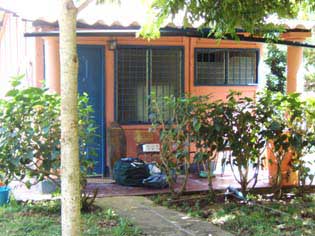
This is the house where the vijilante, the gate keeper stays and looks over the land. |
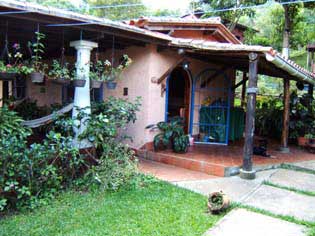
This is the entrance to the main house. Inside is the kitchen, and to the left is the deck, or a small living area. These two houses you have just seen were included with the land and in the future will be expanded or replaced with different and bigger buildings. |
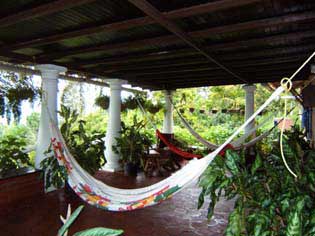
These are amacas, hammocks. After honoring prasadam and finishing the interviews some devotees laid here to rest. During the small siesta, Antarjami Prabhu took me around the land to see the many trees and some animals. |

The small dog that greeted us at the driveway just recently gave birth to these cute little puppies. There were about six of them, a few weeks old. All were pretty healthy and starting to move around except one. |
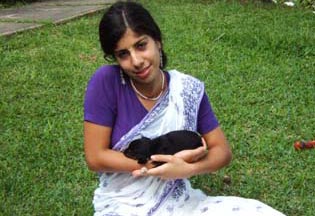
Weak and unable to eat anything, the poor puppy kept whimpering and shaking. I took it in my arms and let him sit in the sun. Chintamani Devi Dasi prepared a little bottle with milk to feed him, but it wasn't very successful since he didn't swallow much of it. |
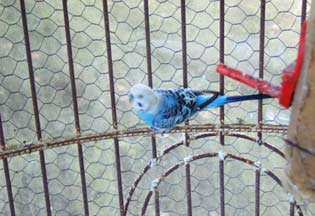
Apart from the newborn puppies, the mom, and another puppy named Durga, there are also parakeets in a shady spot beneath the bamboo trees. |
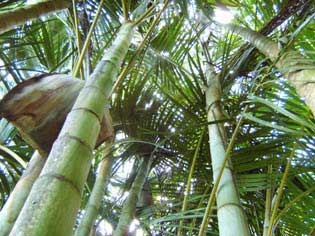
We walked past the bamboo trees and started going up a slope. Antarjami Prabhu began pointing out more trees and plants: |
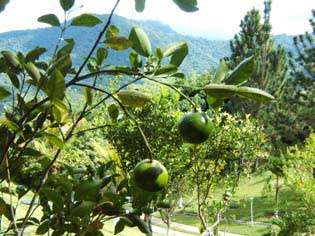
Lime trees. |
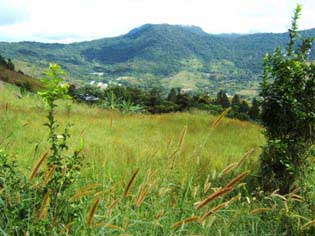
We made our way up a small stone path and sat on a cement water tank to take in the view over the land. This small clearing will be flattened, weeded, and an ashram will be built here for the brahmacharis or ladies. |

To our left, the line of pine trees marks the boundary of the ashram terrace. In the distance, the mountains nestled in clouds of fog and below, the light color of the house glittered through the fresh green leaves. |
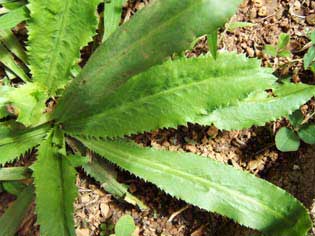
Walking down the path we came across a culantro plant, wild cilantro. I later asked Chintamani Devi Dasi about this plant and she mentioned that she had used it to spice the sauce for the pasta she made for lunch. It has a sharp yet zesty taste. |
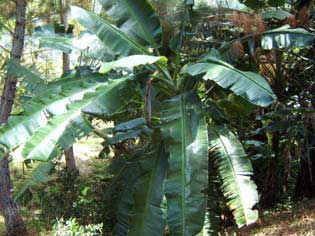
Walking further along the path towards the house I saw several kambur trees. |
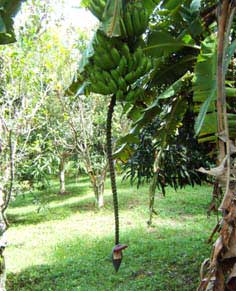
I spotted one kambur tree with a bunch of bananas and a vine hanging from it. |
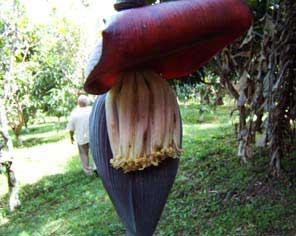
Walking closer I saw that it was a banana flower. It was the first time I had ever seen one. It reminded me of some sort of tongue. How strange it was with its deep fleshy colors and light soft tendrils. I ran to catch up with Antarjami. |
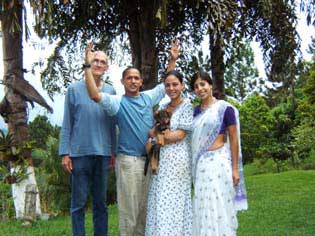
|
|
| Click
here to read Interviews about the New Land
|
|